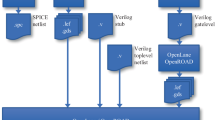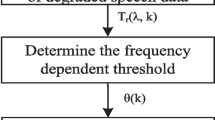Abstract
Blind source separation of independent sources from their convolutive mixtures is a problem in many real-world multi-sensor applications. However, the existing BSS architectures are more often than not based upon software and thus not suitable for direct implementation on hardware. The existing software of feedback network algorithm is not suitable for real-time implementations. In this paper, we present a parallel algorithm and architecture for hardware implementation of blind source separation. The algorithm is based on feedback network and is highly suited for parallel processing. The implementation is designed to operate in real time for speech signal sequences. It is systolic and easily scalable by simple adding and connecting chips or modules. In order to verify the proposed architecture, we have also designed and implemented it in a hardware prototyping with Xilinx FPGAs running at 33 MHz.
Similar content being viewed by others
References
C. Jutten and J. Herault, “Blind Separation of Source, Part I: An Adaptive Algorithm Based on Neuromimetic Architecture,” Signal Process., vol. 24, 1991, pp. 1–10.
K. Torkkola, “Blind Separation of Convolved Sources Based on Information Maximization,” Proc. IEEE Workshop Neural Networks for Signal Processing, 1996, pp. 423–432.
Hoang-Lan Nguyen Thi and Christian Jutten, “Blind Source Separation for Convolutive Mixtures,” Signal Process., vol. 45, 1995, pp. 209–229.
T. Nomura, M. Eguchi, H. Niwamoto, H. Kokubo, and M. Miyamoto, “An Extension of The Herault–Jutten Network to Signals Including Delays for Blind Separation,” IEEE Neural Networks Signal Processing, vol. VI, 1996, pp. 443–452.
S. Choi and A. Cichocki, “Adaptive Blind Separation of Speech Signals: Cocktail Party Problem,” Proc. Int. Conf. Speech Processing (ICSP’97), 1997, pp. 617–622. (August)
N. Charkani and Y. Deville, “Self-adaptive Separation of Convolutively Mixed Signals with a Recursive Structure—Part I: Stability Analysis and Optimization of Asymptotic Behaviour,” Signal Process., vol. 73, no. 3, 1999, pp. 255–266.
K. Torkkola, “Blind Separation of Delayed Source Based on Information Maximaization,” Proc. ICASSP, Atlanta, GA, 1996, pp. 7–10. (May)
K. Torkkola, “Blind Source Separation for Audio Signal—Are We There Yet?” IEEE Workshop on Independent Component Analysis and Blind Signal Separation, Aussois, France, 1999. (Jan)
K. C. Yen and Y. Zhao, “Adaptive Co-channel Speech Separation and Recognition,” IEEE Trans. Speech Audio Process., vol. 7, no. 2, 1999, pp. 138–151.
A. Cichocki, S. Amari, and J. Cao, “Blind Separation of Delayed and Convolved Signal with Self-adaptive Learning Rate,” in NOLTA, Tochi, Japan, 1996, pp. 229–232.
S. Amari, S. C. Douglas, A. Cichocki, and H. H. Yang, “Novel On-line Adaptive Learning Algorithms for Blind Deconvolution Using the Natural Gradient Approach,” in IFAC Symposium on System Identification, Fukuoka, Japan, 1997.
T. Lee, A. Bell, and R. Lambert, “Blind Separation of Delayed and Convolved Source,” in Advances in Neural Information Processing Systems, MIT Press, 1997.
N. Charkani and Y. Deville, “Optimization of the Asymptotic Performance of Time-domain Covolutive Source Separation Algorithms,” in ESANN, Brugers, Belgium, 1997, pp. 273–278.
Author information
Authors and Affiliations
Corresponding author
Rights and permissions
About this article
Cite this article
Jeong, H., Kim, Y. A Systolic Architecture and Implementation of Feedback Network for Blind Source Separation. J VLSI Sign Process Syst Sign Image Video Technol 47, 117–126 (2007). https://doi.org/10.1007/s11265-006-0036-3
Published:
Issue Date:
DOI: https://doi.org/10.1007/s11265-006-0036-3




